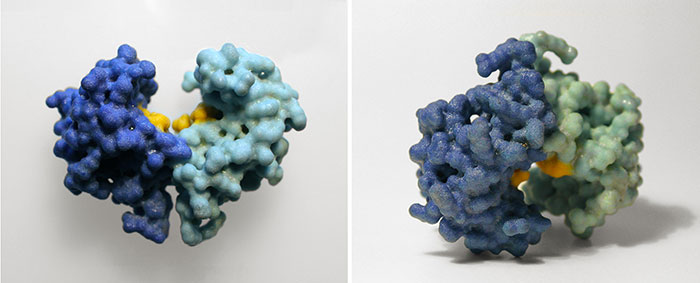Brooklyn, NY, based Biologic Models has been producing and experiencing quite a bit of growth in the demand for its physical models of proteins and molecules, cleverly described by Wired UK as “Protein Action Figures”. The company produces a wide range of 3D printed models specifically on request by doctors, academic institutions and even regular people interested in finding out more about the way proteins work.

Medical applications of 3D printing are one of the fastest growing segments both in terms of additive manufacturing adoption and for the benefits that these new technologies are introducing, especially for customized implants and pre-surgical modelling. The team behind Biologic Models believe that 3D printed educational models can also provide a wide range of benefits, for example by enabling doctors to show patients the impact of disease, thus addressing therapies in a more efficient and understandable way.
The same applies to sales representatives, who use the 3D models to explain the science behind the products they are selling, as well as teachers, who can use them to effectively explain science concepts to their students.
Biologic Models’ 3D prints can be custom tailored to meet healthcare, educational and even promotional activities. All models can also be colour coded to reveal important information about hydrophobicity, atom types, binding and active sites within the protein structure.
Each protein models is created beginning with X-ray crystallography data-sets of actual proteins, which are then brought to life through additive manufacturing and then, if demand requires it, injection moulded into consumer grade products.
Custom 3D printed proteins vary in price based upon their physical size, material selection, printer fees and model complexity. Injection moulded models benefit from bulk material purchases and scale economics so, once demand is high enough, or orders are large enough, savings can be passed on to customers. Crowd funding is the third option.
Biological Models launched the Rockethub campaign (which reached its $5000 goal) to produce a sufficient number of Hemoglobin A1c (HbA1c) teaching models to help people who suffer from diabetes understand how the Hemoglobin A1c (HbA1c) blood test works. The kit contained two informational cards that describe each protein and two teaching models: normal Oxygenated Hemoglobin (Hb), and Glycated Hemoglobin A1c (HbA1c). The comparison between the two models provides an immediate visual metaphor of the controlled and uncontrolled blood glucose metabolism caused by diabetes.
The full HbA1c Educational Kit sold for $425 but the campaign also offered a premium reward to those contributing with $1000 or more: their own choice of 3D printed molecule, selected from the RCSB database, in transparent SLA resin. Prices are still a bit steep but soon enough you might just want to start your own “molecule action figure” collection.



